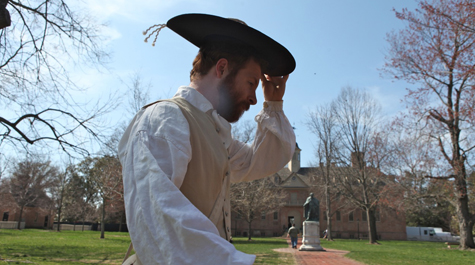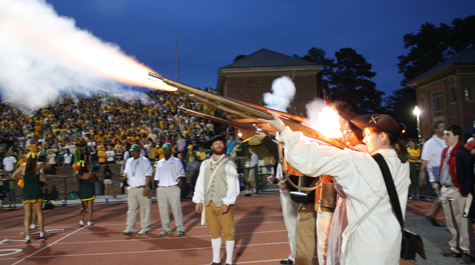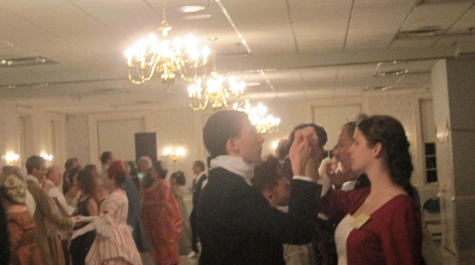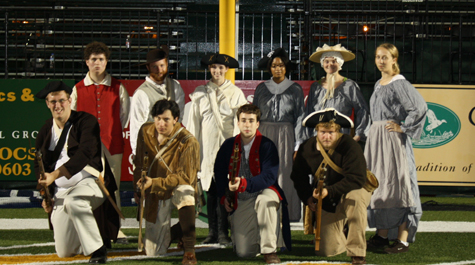1783: A day in the life of the College
Senior organizes a trip back into the College's history
This Saturday, the Sir Christopher Wren building is going back to the year 1783, with or without a flux capacitor.
Visitors will be able to see classes, activities and merriment in a living history event portraying the College of William & Mary right after the American Revolution. The event will be held from 10:30 a.m. to 4:00 p.m.
“The event is scheduled to include 18th-century science demonstrations, fencing and dancing lessons, a militia muster, a lecture from lecture notes in the W&M archives, and an enactment of a student getting chewed out for misbehavior in the Blue Room,” said Tracy Jenkins ’12, who organized the event.
Jenkins is a member of living history group The College Company and the Spotswood Society, which provides tours of the historic campus. He reached out across campus and beyond the William & Mary community to bring this event together.
“I’m doing my best to cover all bases on different facets of life at the College,” Jenkins said.
Work and Play
Since the College is an academic institution, of course there will be classes. David Corlett, the assistant director of the National Institute of American History and Democracy (NIAHD) will present lectures found in the University Archives from the late 18th century.
“It’s … interesting to contrast the kinds of classes they were taking back then to what we’re taking now and the way various disciplines have changed over the years,” Jenkins said.
The event will also feature 18th-century science demonstrations and experiments by Dean Howarth, a Fairfax County science teacher and Jenkins’ high school physics teacher.
Jenkins said there would not be a reenactment of Benjamin Franklin’s famous experiment involving lightning, a kite and a key, but he put in “a special request for electrostatics.”
“This was back when they thought electricity was a fluid,” he said.
Of course, no academic experience—even one in 1783—would be complete without extracurricular activities, so Jenkins invited the William & Mary Heritage Dancers to hold a dance in the Great Hall.
“The Heritage Dancers are a group of students who enjoy doing English country dance,” said Laura Faircloth ’13, the club’s president. “We decided to be part of this event because dancing was an important social event during the colonial period, and we would like to show the audience that it can be great fun as well.”
Jenkins will also be presenting a fencing demonstration.
“You can’t really think of school without extracurriculars, and I think you need something more than book-learning,” Jenkins said. “In the 18th century, dancing and fencing were part of a gentleman’s education.”
Military Might
Life at William & Mary in 1783 was not simply carefree. The College was grappling with being part of the newly formed United States and losing all of its royal funding. The fighting had ended, but the Treaty of Paris had not yet been signed. To reflect that, Jenkins organized a militia muster with the William & Mary-based College Company and the Virginia-based 7th Virginia Regiment.
“It’s basically to call out the militia, ‘Let’s train for the day and make sure we don’t get too rusty, just in case,’” Jenkins said. “The bigger point is just to demonstrate that we’re at the end of a war. We’ve been in a war for a year; the war has affected the College.”
Today, the College Company and 7th Virginia are living history groups. According to the College Company’s president Kelsey Svoboda ’12, the company does “anything that we can remotely relate to American history,” including military reenactments and musket volleys at home football games.
“The College Company takes its name from the militia company that was formed out of the student body and the faculty during the Revolutionary War,” Jenkins said. “In 1777, the president of the College was actually given a commission as a militia captain. He’s a math professor; he’s a clergyman.”
Likewise, the 7th Virginia Regiment was historically part of the Continental Army fighting the British during the Revolutionary War.
“[Today,] the 7th Virginia is one of many Revolutionary War reenacting units in the country made up of people with a passion for history, particularly the American Revolution and/or the colonial period,” said Mike Cecere, the commander of the 7th Virginia Regiment and an American history teacher in Fairfax county. “The 7th Virginia always tries to embrace opportunities to promote Virginia's role in the American Revolution, and this event is just such an effort to do that.”
Jenkins and the College Company organized a smaller scale event at the Wren Building two years ago that consisted solely of a militia encampment.
“We’re growing this event out of the one we did before, making it bigger, making it more complex, trying to get a fuller picture,” Jenkins said.
Challenges
There are challenges to holding an event that transports an audience back in time, since groups like the College Company and the Heritage Dancers will be engaged in first-person interpretation, which means that they will take on the roles of the people living in the 18th century.
“When you’re in first-person, you don’t want to step out of character too much, because first-person interpretation requires a certain suspension of disbelief,” Jenkins said. “We’re interpreters, and, in order to maintain a level of integrity, we often try to stay in character as much as possible. So, third person interpretation is really important to round that out by being able to give a broader historical context for what the first-person interpreters are talking about.”
Third-person interpretation, Jenkins explained, is the act of looking back at the history and contextualizing it. History classes are an example of third-person interpretation, as are the tours of historic campus given by members of the Spotswood Society. On Saturday, students in the Spotswood Society will be fleshing out the historical events that lead to and follow William & Mary in 1783.
“If we’re going to talk about history, we should try to see things through the eyes of the people who lived it, and that’s what first person interpretation is about,” Jenkins said. “But, we should also figure out what this history means for us, and that’s what third-person interpretation is about. You can’t really have one without the other without losing something in the process.”
Another challenge was presenting the role of Native Americans and African Americans in the College’s history. A member of the College Company volunteered to present a first-person portrayal of a slave, and third-person interpreters will discuss slavery and the history of the Brafferton School, which served as a school for Native Americans.
“It’s a part of the College’s history that wasn’t pretty,” said Kimberly Renner, assistant director of the historic campus. “I think we’re not telling the history until we tell the whole story. Tracy is following right in with The Lemon Project and with the new track the College is taking on looking at the history, and I’m really excited about that aspect.”
Looking Back, Looking Forward
The interaction between modern-day visitors and living historians will be a fluid, changing experience during the event.
“The event is only going to be set in stone once it’s over,” Jenkins said. “Even when something’s happening, the visitors that you get and the questions they ask change the interpretation that you do. If you have kids, then you’re going to present the interpretation a different way than when you have a group of retirees.”
This fluidity is the strength of a living history event, Cecere said.
“When living history events are done effectively, they provide visitors with a more personal experience with the past,” he said. “I think witnessing or interacting with living historians also leaves a strong impression on many people, much more so than merely reading about a particular event in a book or on a trail sign. Of course, we can't possibly convey to visitors everything they should know about a historic event or site, so our hope is that they will indeed go and read more about the history that they learned from our event.”
Jenkins devoted a large part of his senior year setting the foundation for and orchestrating this living history event.
“This is Tracy’s legacy to the College as a senior,” Renner said. “He loves the College, and he loves the history of the College and of this area, so this is a great way for him to pull this together and create this amazing event and get everyone involved, and I hope this continues.”


















